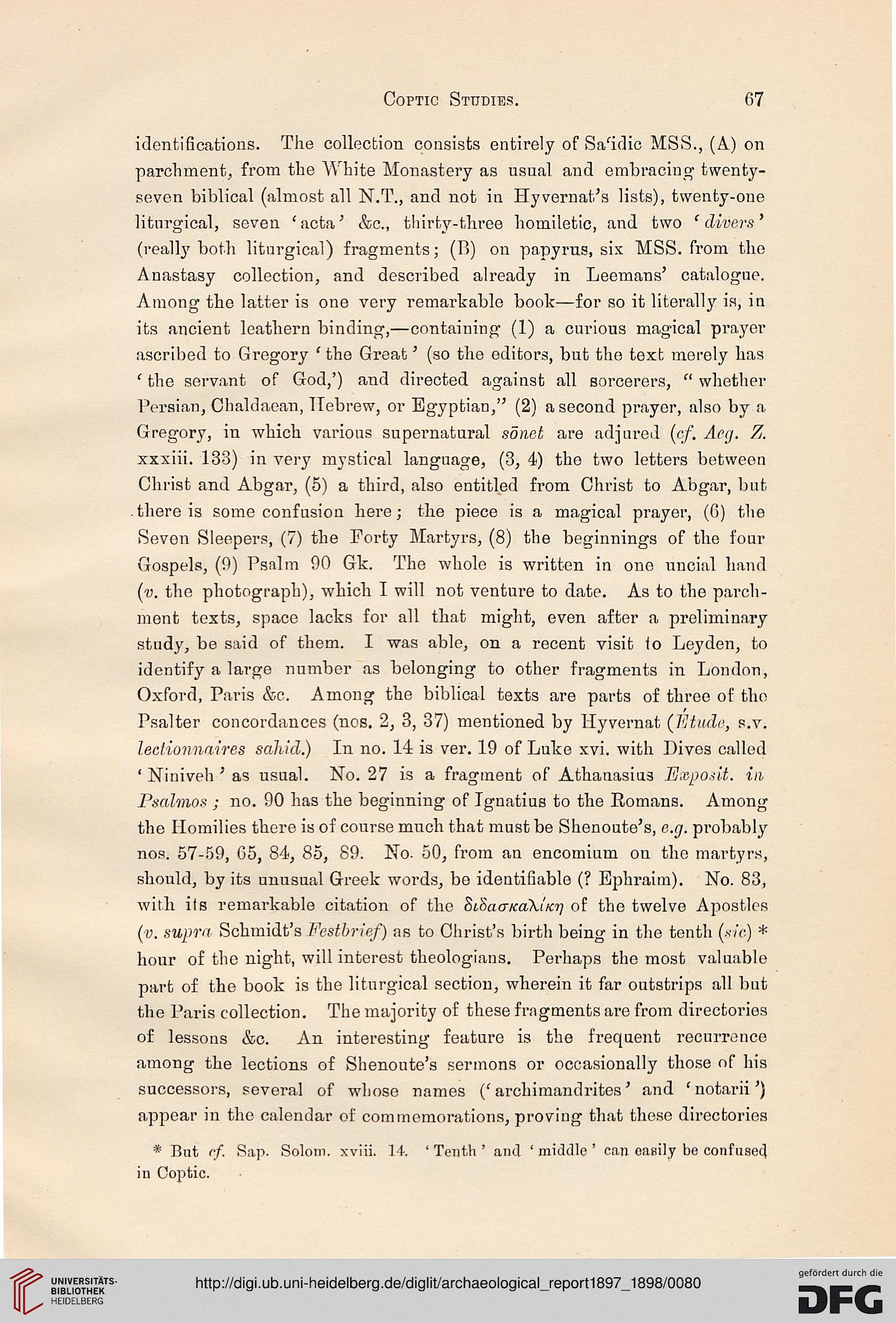Coptic Studies.
67
identifications. The collection consists entirely of Sa'idic MSS., (A) on
parchment, from the White Monastery as usual and embracing twenty-
seven biblical (almost all N.T., and not in Hyvernat's lists), twenty-one
liturgical, seven 'acta' &c, thirty-three homiletic, and two 'divers'
(really both liturgical) fragments; (B) on papyrus, six MSS. from the
Anastasy collection, and described already in Leemans' catalogue.
Among the latter is one very remarkable book—for so it literally is, in
its ancient leathern binding,—containing (1) a curious magical prayer
ascribed to Gregory ' the Great' (so the editors, but the text merely has
' the servant of God,') and directed against all sorcerers, " whether
Persian, Chaldaean, Hebrew, or Egyptian," (2) a second prayer, also by a
Gregory, in which various supernatural sonet are adjured (cf. Aeg. Z.
xxxiii. 133) in very mystical language, (3, 4) the two letters between
Christ and Abgar, (5) a third, also entitled from Christ to Abgar, but
there is some confusion here; the piece is a magical prayer, (6) the
Seven Sleepers, (7) the Forty Martyrs, (8) the beginnings of the four
Gospels, (9) Psalm 90 Gk. The whole is written in one uncial hand
(v. the photograph), which I will not venture to date. As to the parch-
ment texts, space lacks for all that might, even after a preliminary
study, be said of them. I was able, on a recent visit to Leyden, to
identify a large number as belonging to other fragments in London,
Oxford, Paris &c. Among the biblical texts are parts of three of the
Psalter concordances (nos. 2, 3, 37) mentioned by Hyvernat (Etude, s.v.
leclionnaires sahid.) In no. 14 is ver. 19 of Luke xvi. with Dives called
' Niniveh ' as usual. No. 27 is a fragment of Athanasius Expoiit. in
Paalmos ; no. 90 has the beginning of Ignatius to the Romans. Among
the Homilies there is of course much that must be Shenouto's, e.g. probably
nos. 57-59, G5, 84, 85, 89. No. 50, from an encomium on the martyrs,
should, by its unusual Greek words, bo identifiable (? Ephraim). No. 83,
with ils remarkable citation of the SiSaaKaXiKij of the twelve Apostles
(v. supra Schmidt's Festbrief) as to Christ's birth being in the tenth (sic) *
hour of the night, will interest theologians. Perhaps the most valuable
part of the book is the liturgical section, wherein it far outstrips all but
the Paris collection. The majority of these fragments are from directories
of lessons &c. An interesting feature is the frequent recurrence
among the lections of Shenoute's sermons or occasionally those of his
successors, several of whose names ('archimandrites' and 'notarii')
appear in the calendar of commemorations, proving that these directories
* But cf. Sap. Solom. xviii. 14. 'Tenth' and 'middle' can oasily be confused,
iu Coptic.
67
identifications. The collection consists entirely of Sa'idic MSS., (A) on
parchment, from the White Monastery as usual and embracing twenty-
seven biblical (almost all N.T., and not in Hyvernat's lists), twenty-one
liturgical, seven 'acta' &c, thirty-three homiletic, and two 'divers'
(really both liturgical) fragments; (B) on papyrus, six MSS. from the
Anastasy collection, and described already in Leemans' catalogue.
Among the latter is one very remarkable book—for so it literally is, in
its ancient leathern binding,—containing (1) a curious magical prayer
ascribed to Gregory ' the Great' (so the editors, but the text merely has
' the servant of God,') and directed against all sorcerers, " whether
Persian, Chaldaean, Hebrew, or Egyptian," (2) a second prayer, also by a
Gregory, in which various supernatural sonet are adjured (cf. Aeg. Z.
xxxiii. 133) in very mystical language, (3, 4) the two letters between
Christ and Abgar, (5) a third, also entitled from Christ to Abgar, but
there is some confusion here; the piece is a magical prayer, (6) the
Seven Sleepers, (7) the Forty Martyrs, (8) the beginnings of the four
Gospels, (9) Psalm 90 Gk. The whole is written in one uncial hand
(v. the photograph), which I will not venture to date. As to the parch-
ment texts, space lacks for all that might, even after a preliminary
study, be said of them. I was able, on a recent visit to Leyden, to
identify a large number as belonging to other fragments in London,
Oxford, Paris &c. Among the biblical texts are parts of three of the
Psalter concordances (nos. 2, 3, 37) mentioned by Hyvernat (Etude, s.v.
leclionnaires sahid.) In no. 14 is ver. 19 of Luke xvi. with Dives called
' Niniveh ' as usual. No. 27 is a fragment of Athanasius Expoiit. in
Paalmos ; no. 90 has the beginning of Ignatius to the Romans. Among
the Homilies there is of course much that must be Shenouto's, e.g. probably
nos. 57-59, G5, 84, 85, 89. No. 50, from an encomium on the martyrs,
should, by its unusual Greek words, bo identifiable (? Ephraim). No. 83,
with ils remarkable citation of the SiSaaKaXiKij of the twelve Apostles
(v. supra Schmidt's Festbrief) as to Christ's birth being in the tenth (sic) *
hour of the night, will interest theologians. Perhaps the most valuable
part of the book is the liturgical section, wherein it far outstrips all but
the Paris collection. The majority of these fragments are from directories
of lessons &c. An interesting feature is the frequent recurrence
among the lections of Shenoute's sermons or occasionally those of his
successors, several of whose names ('archimandrites' and 'notarii')
appear in the calendar of commemorations, proving that these directories
* But cf. Sap. Solom. xviii. 14. 'Tenth' and 'middle' can oasily be confused,
iu Coptic.





